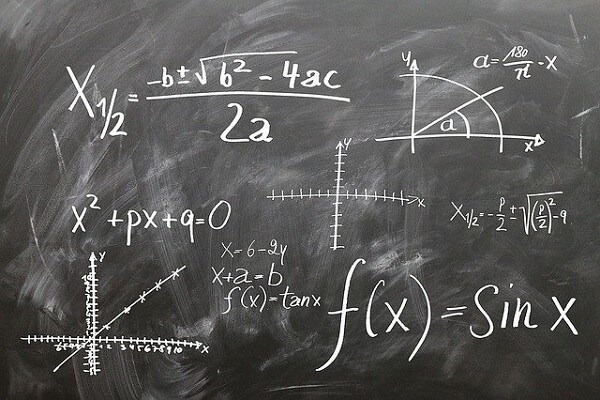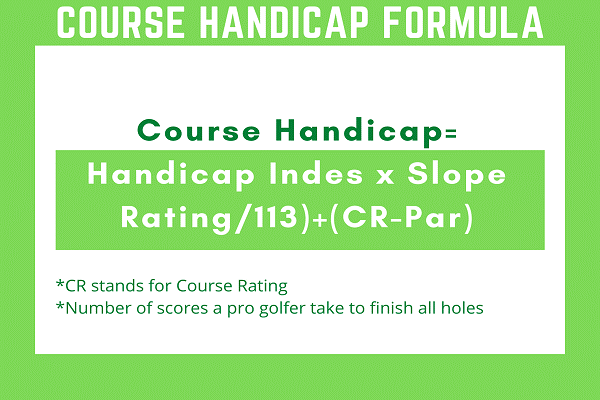Table of Contents
Before I explain to you how does a golf handicap works, let me ask you a question.
What would you say If I ask you to compete with Usain Bolt in the 100 m sprints? You probably would say IT’S UNFAIR!.. Right?
After all, Usain Bolt is a pro sprinter. He can run a lot faster than you. And you have no chance to win against him. Agreed.
But wait! What if I say, you would start your run 50m ahead of Bolt?
Now it makes sense. Now, you have a fair chance to win, don’t you? What I did here is, I leveled the gap between the skills of Usain Bolt and you, to give you a fair chance to taste victory.
The same thing applies to Golf. As you know that different golfers have different abilities and without a handicap, it is pretty obvious that there is almost no chance to register a victory for amateur golfers against the scratches.
So, to make the sport of Golf fair, enjoyable and to give amateur golfers a fair chance of winning tournaments, the concept of Handicap was introduced in Golf. A Handicap is a conceptual tool to make the sport of golf more competitive and just.
In this article, I’ll explain to you almost everything about the golf handicap that will help you understand the sport of Golf better. And, this will also help you become a better golfer.
So, without beating the bush, let’s dive into it.
WHAT IS A GOLF HANDICAP?
A Golf Handicap is a numeric index that tells about how many extra strokes a player can play in each round over par of the course. Here, par stands for the number of strokes a pro golfer takes to finish18 holes. A handicap indicates the golfer’s ability comparative to the other golfers and vice versa.
Suppose that you are a 6-handicapper and your friend is a 10-handicapper and you are playing with him on18-hole course with par 72. Now, since you have a handicap of 6, you have to finish the holes in 78 strokes while your friend, being a 10-handicapper, will get 82 strokes.
This indicates that the lower the handicap is, the better the player is considered. So, you with a handicap of 6 are a better player than your friend who is a 10-handicapper.
“A handicap can be anywhere between 0 zero and 28 for men and between zero and 36 for women. Pro or scratch golfers have zero handicaps while the golfers who are known as ‘Plus Makers’(top-level players) have to add strokes to their final score.”
Best Golf Drivers for Mid Handicap
World Golf Handicap (WGH)
Before January 2020, different regions of the world had a different system of calculating the handicap. This was very confusing and difficult to understand. The new World Handicap System was launched to:
- Promote the Sport of Golf
- Bring uniformity among the different tournaments so that the golfers can participate in the international tournaments.
- To clear confusion and make golf easier to understand
Some of the major changes that took place after the introduction of the WHS are- daily revisions to keep the handicap up-to-date, consideration of weather conditions, and implementation of a net double-bogie system.
How Does the Golf Handicap System Work?
The golf handicap system is a bit confusing and involves some Maths but if you pay attention it’ll be clear to you. Remember! You can have one and only one handicap irrespective of the difficulty level of the course.
How is the Course Handicap Calculated?
If you carry an official USGA Handicap Index, then you need not worry about the scary calculation of Handicap. Most golf clubs do this job for their players. All you need is to submit your Adjusted Gross Score to the club and the rest of the job will be taken care of by the computers.
However, you can’t help out your inquisitive nature and really want to quench your thirst for knowing the Maths behind the Handicap.
To understand how the Course Handicap is calculated there are few things that you must know beforehand. These are— Adjusted Gross Score, Course Rating(CR), Slope Rating (SR). Let’s understand these terms:
Adjusted Gross Scores
According to the rules of Handicapping USGA, it is the score that is calculated based on the pre-hole maximum score, set by the USGA; in the Equitable Stroke Control (ESC) Guidelines. In simple words, the USGA had set the maximum limit on the number of strokes a golfer can play for on each hole during a handicap round.
Course Rating
Course rating as the name suggests is based on the golf course. It is the expected or hypothetical score of the scratch/pro golfer(a golfer with a zero handicap) on the course of 18 holes.
Slope Rating
Slope rating, on the other hand, is a measure of the difference in the anticipated score of the pro and ‘bogey golfer’.
What is the meaning of double-bogey, triple-bogey, and quadruple-bogey?
Basically, double-bogey, triple-bogey, and quadruple-bogey are the scores of two, three, and four strokes over par of an individual hole respectively. Still, confused? Let me elaborate…
…You see, each hole on a golf course has a par, i.e. number of strokes needed to put the ball in that hole by a pro golfer. Say, there is a hole on a golf course having par at 7 but you took 9 strokes to put the ball in that hole. So, you are 2-strokes above par, you made a double-bogey here.
Similarly, 3-strokes over par are known as triple-bogey and 4-strokes over par are called quadruple-bogey.
If we look at the broader picture, a golfer who makes double-bogey in all 18 holes will be 36-strokes over par(2 strokes over par in for 18 holes). Most of the beginners and recreational golfers are double or triple-bogey golfers.
Best golf irons for 20 Handicap
Course Handicap Calculation and Formula
Now, you have got everything you need to calculate your Course Handicap:
- You have your Adjusted Gross Score
- You have the Course Rating, and
- You have the Slope Rating
Now, all you need is to calculate the Course Handicap. It will be done in 7 steps.
Step 1 – Change Your Gross Scores into Adjusted Total Scores
Use the ESC table to convert your Gross Scores to Adjusted Total. The ESC rule comes into effect when a golfer takes more than the maximum strokes to finish the hole. So, in that case, the adjusted score is taken as the maximum limit set in the ESC table.
For example, suppose that for a hole with Course Handicap 10-19, whose maximum limit is fixed 7 strokes; you took 9 strokes to finish, then you will enter your score as 7 because this is the maximum limit of the concerned hole.
Equitable Stroke Control for 18-Holes Golf Course
| Course Handicap | Maximum Number on Any Hole |
| 0-9 | Double Bogey |
| 10-19 | 7 |
| 20-29 | 8 |
| 30-39 | 9 |
| 40 or more |
10 |
Calculate Your Handicap Differential for Each Score
Now, use the following formula to find out your Handicap Differential:
Handicap Differential= (Adjusted Gross Score – Course Rating) X 113/ Slope Rating
For example, let’s say your score is 80, the Course Rating is 72.2 and the Slope Rating is 130. Then your Handicap Differential will be:
(80-72) X 113/ 130= 6.78
* Here, 113 is a constant termed as the Slope Rating of a course with standard difficulty.
Step 3: Select the Lowest Handicap Differential
Next, choose the lowest and the best handicap differential. To do that, select your lowest 10 out of 20 scores.
Step 4: Calculating the Average of the Differentials
After selecting your best and the lowest scores, the next step is to take out the average of the Handicap Differential. For this, you need to take out the average of the lowest 3 scores for 10 HDs, an average of 6 for 15 HDs, and 20 HDs take out the average of the lowest 10 scores.
Step 5: Multiply the Average with of Handicap Differential with 96%
The 5th step is to determine the 96% of average differential. In other words, multiply the average differential by 0.96.
Step 6: Truncate the Average Handicap up to the Tenths Place
In this step, you need to remove the long decimal expansion from the Average Handicap and write it up to the tenths place.
For example, if the average of your Handicap Differential is 14.123 it will be taken as 14.1.
As per USGA, the maximum number of Handicap Index for men can be 36.4 and for women, it can be 40.4 on an 18-hole course.
Step 7: Calculate the Course Handicap
The final step is to calculate the Course Handicap. You have to use the following formula to calculate it:
For example, assume that your Handicap Index is 12.5, the Slope Rating is 114 and the Course Rating is 73 and 72 then, your Course Handicap will be
Course Handicap= (12.5 x 114/ 113) + (73-72)
= 13.6
Still, confused about the topic? You may watch the following video to get a better understanding.
Golf Handicap Calculator
If you want to consistently monitor your handicap to track your progress you can also use Online Golf Handicap Calculators. One of such calculators, you will find on calculator.net. Or, if you don’t want to go on your computer you can use an app to calculate your golf handicap on your android smartphone.
You may also compare your handicap against the rest of the golfers in the USA by referring to the Golf Handicap Index Chart published by USGA.
What is the Difference Between ‘Handicap’ and ‘Handicap Index’?
Difference Between ‘Handicap’ and ‘Handicap Index’
Handicap Index |
Handicap |
| ‘Handicap Index’ is the official handicap established by a legitimate governing body, like USGA under a handicap system. | ‘Handicap’ refers to the general score of a golfer above par. 10 over par means 10 handicaps. |
| ‘Handicap Index’ can be used in official tournaments. | ‘Handicap’ cannot be used in any official tournaments. |
| It is kept through and calculated by official bodies such as USGA, CONGU, etc.) | Players can keep the record of their handicaps by themselves. No official body is required to authorize the handicap. |
Average Handicap by Age
| Age | Average Handicap |
| 20-30 | 18 |
| 30-40 | 20 |
| 40-50 | 20 |
| 50-60 | 19 |
| 60 and above | 20 |
| All Golfers | 19 |
How Can You Bring Your Handicap Down Fast?
8 Tips To Lower Your Handicap Quickly
- Go to the range frequently
- You must practice your SHORT GAME
- Use proper equipment especially, the clubs.
- Concentrate on your fitness
- Learn to play on different courses.
- Practice alone if you don’t have anyone to practice with.
- Track your progress
- Maintain actual handicap without cheating yourself.
Check our previous post: What is a Good Handicap in Golf?
FAQs:
How does a golf handicap work on a scorecard?
First, you need to locate the Slope Rating and Course Rating on the scorecard. Now, to find a golf handicap, multiply your Average Handicap Index to Slope Rating and divide it by 113; after that add the difference between the Course Rating and PAR. The number which you get as result is your handicap.
What is a really good handicap in golf?
According to experts, a good handicap in golf can be more or less 10 over par. This means if you are finishing all the 18-holes in 82 strokes on a golf course of 72 par then you have a 10- handicap, which is pretty good.
Is a 30 handicap in golf good?
The Lower the handicap is always better. A golf handicap is around 10. If you go up then your skills will go down. As far as 30-handicap is concerned it is more than the average handicap, i.e. 15.
What's my handicap if I shoot 85?
If you shoot 85 on a golf course of a par 72 then your handicap is 85-72 = 13. What Is My Golf Handicap If I Shoot 85? If you play a par 72 course and shoot 85, you are probably around a 13 handicap.
What is my golf handicap if I shoot 100?
If you are playing on a golf course of a par 72 for 18-holes then, simply, subtract 72 from 100. So, if you finish all the holes in 100 strokes then your handicap is 100-72= 28
What is a good golf handicap for a beginner?
A good handicap for beginners can be anywhere between 25 to 30. This means that if you are finishing all the holes in more or less 100 strokes then it will be considered as a good handicap as a beginner.
I hope now you are well familiar with the golf handicap system and able to calculate your Handicap. Visit Golferarena for more useful information and tips.


